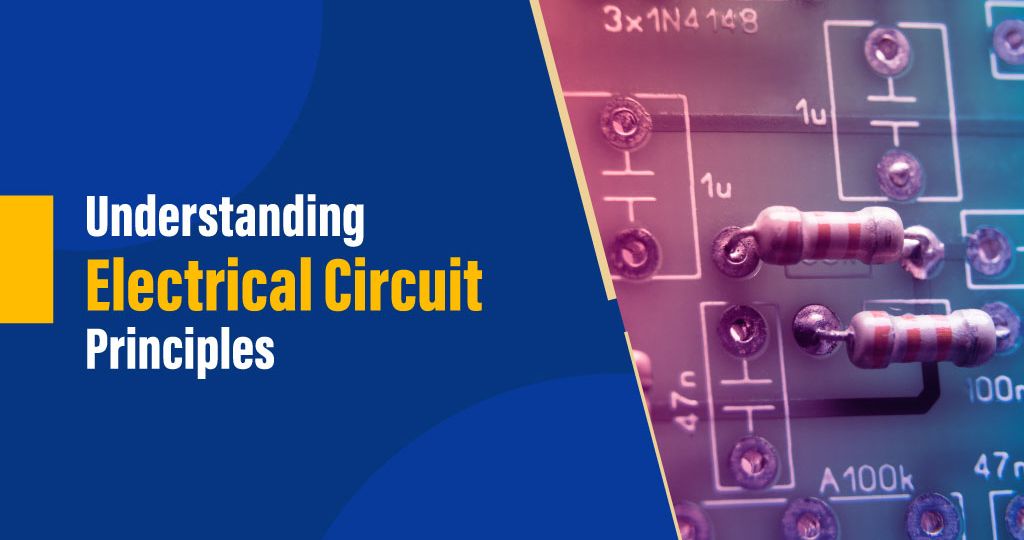
Circuit theory is the base for electrical engineering and provides the framework for designing, analyzing, and troubleshooting electrical circuits. In this blog, let’s delve into the essential concepts of circuit theory, which provide you with insights on both the theoretical aspects and practical applications of circuit theory.
What is circuit theory?
It focuses on the detailed study of interconnected electrical components and their behavior in a circuit. Circuit theory is all about how current passes through circuits and various components to perform specific functions, like powering devices or transmitting signals. It serves as a pathway for electric current to flow from one point to another. It consists of three basic components, which comprise a voltage source, a conductive path, and a load.
Electric circuit: fundamental components:
Voltage Source: The voltage source injects energy into the circuit through a potential difference between its positive (+) and negative (-) terminals. Voltage sources are categorized as either AC or DC, wherein the primary difference lies in the direction of current flow.
AC sources generate voltages that fluctuate sinusoidally, meaning the current undergoes periodic reversals in direction. Common examples include power derived from the grid or generators.
Whereas DC sources supply current that travels in a singular direction. Batteries serve as a quintessential source of DC voltage.
Conductive Path: A conductive path, also called the conductor, serves as a channel for current flow within a circuit. These elements exhibit minimal resistance to the flow of electricity and commonly include materials like copper wires, lead solder, or metallic traces on a printed circuit board (PCB).
Conductors are key to connecting various components within a circuit to achieve a single function.
Load: A load represents any device within a circuit that consumes electrical power and includes multiple devices like light-emitting diodes (LEDs), motors, sirens, etc.
In the event of a short circuit, the load becomes the conductor, generating heat as it dissipates electric power.
Pursuing ECE programs at the best electronics and communication engineering colleges in Tamil Nadu opens you to a multitude of exciting career opportunities in the field.
Component types in electronic circuits:
Electronic components shape the behavior and functionality of electric circuits and are broadly classified into three main categories: passive, active, and electromechanical.
Passive Components: Passive components are fundamental elements within electronic circuits that consume electric power without introducing any net energy into the system. Instead, they dissipate energy in the form of heat or store energy temporarily.
Common examples of passive components include resistors, capacitors, and inductors. Resistors hinder the flow of current, while capacitors store electrical energy in an electric field, and inductors store energy in a magnetic field.
Active Components: Active components are devices that control the flow of current within electric circuits. Unlike passive components, active components can introduce energy into the circuit and amplify or modulate electrical signals.
These components are essential for signal processing and amplification. Examples of active components include transistors, thyristors, and vacuum tubes. Transistors, for instance, can amplify or switch electronic signals, making them indispensable in modern electronic devices.
Electromechanical Components: Electromechanical components utilize electric current or voltage to perform mechanical functions within the circuit. These components convert electrical energy into mechanical motion or vice versa. Common examples of electromechanical components include DC motors, relays, and solenoids.
For example, a DC motor converts electrical energy into rotational motion, while a relay uses electrical signals to control the switching of circuits. Solenoids, on the other hand, utilize variations in inductance to actuate mechanical contacts or valves.
Understanding the different types of electronic components is essential for circuit analysis and design. By utilizing passive, active, and electromechanical components effectively, engineers can create sophisticated electronic systems with diverse functionalities.
Karpagam Institute of Technology is one of the top electronics and communication engineering colleges in Coimbatore that empowers aspiring students with industry-ready skills.
Circuit Parameters:
Current and voltage are fundamental parameters of electric circuits, while resistance, inductance, and capacitance are key attributes of electronic components.
Current: Electric current, measured in amperes (A), represents the flow of electrons through a circuit and is and can be either alternating current (AC) or direct current (DC).
Ohm’s Law states that the current between any two points is proportional to the potential difference between them. It is expressed as I = V/R (where I is current, V is voltage, and R is resistance), which allows us to calculate the current flowing through a circuit.
Kirchhoff’s Current Law (KCL) states that the sum of currents entering and leaving a node in a circuit is zero, ensuring conservation of charge.
Voltage: Voltage, also known as electromotive force (EMF), is the potential difference between two points in an electric circuit, measured in volts (V).
Like current, the voltage can be AC or DC. Ohm’s Law can be rearranged to calculate voltage using V = IR (where V is voltage, I is current, and R is resistance).
Kirchhoff’s Voltage Law (KVL) states that the sum of voltages around a closed loop in a circuit is zero, ensuring energy conservation.
Resistance: Resistance is nothing but the ability of the component to impede the flow of current in a circuit and is measured in Ohms (Ω).
It is the ratio of voltage to current, as per Ohm’s Law (R = V/I). Resistors are passive components specifically designed to offer resistance and are commonly used to control current flow in circuits.
Inductance: Inductance refers to the tendency of a conductor to induce a magnetic field when an electric current passes through it, measured in Henrys (H).
Inductors, also known as chokes or coils, store energy in the form of a magnetic field and exhibit inductance. The inductance of a coil can be calculated using L = V/(di/dt), where L is inductance, V is the potential difference, and di/dt is the rate of change of current.
Capacitance: Capacitance represents the ability of a circuit element to store electric charge when a potential difference exists across its terminals, measured in Farads (F).
Capacitors are passive components that exhibit capacitance and store energy in an electric field. The capacitance of a component can be determined using the formula C = Q/V, where C is capacitance, Q is charge, and V is potential difference.
Understanding these fundamental parameters is essential for analyzing and designing electric circuits. By leveraging these principles, you can develop efficient and reliable electronic systems for multiple applications.




